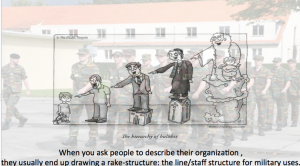Vanavond zit ik live te bloggen tijdens de tweede TEDxHaarlem. Nu zit ik in de prachtige oude bibliotheek van Teylers. Voor mij het scherm met de livestream op een groot filmdoek, een meter voor mij staat het beeldje van Pieter Teylers Hulst. Een betere plek om te vertellen over ontdekkingen en nieuwigheden is niet denkbaar!
Dit is het eerste blog, over de TED-talk van Jaap Peters. Het is in het Engels: alle sprekers praten in het Engels omdat alle video’s van de TED-talks ook in het buitenland moeten worden begrepen.
“In the beautiful old auditorium Jaap Peters behaves as if he addresses audiences in places like this every day. He explains the Rhineland model of business management, why it’s a better suited organisational model in the consultation culture in our society. How does small fits into large?
 Jaap Peters introduces the best CEO of the Netherlands in 2013, Jos de Blok, the founder of Buurtzorg. He calls him the Dutch Maverick. Jos has nearly 7.000 employees, but no managers, no management team, no management meetings. And his way of working costs less than other care institutes. All professionals are self-directed.
Jaap Peters introduces the best CEO of the Netherlands in 2013, Jos de Blok, the founder of Buurtzorg. He calls him the Dutch Maverick. Jos has nearly 7.000 employees, but no managers, no management team, no management meetings. And his way of working costs less than other care institutes. All professionals are self-directed.
What is the opposite? “Just stick to the plan, do whatever the instructions say, don’t question them.” On the screen behind him you see a lamppost standing in the middle of the road an another one blocking a parking space. Jaap calls this “big within big.”
In his book “Human Livestock Management” he compares our way of organising to factory farming. It’s always about large, the concept of size in relation to dignity. Animals loose their dignity because they don’t complain of how their living is organised. As a consumer you don’t look at how an organisation is organised.
In the Western world we’re used to a business management structure that came from the military world in the USA. We call that the Anglo-Saxon model. The base of that concept was laid by Fred Taylor. He tailored the military organisation, because they used the rake (NL: organigram) to structure their hierarchy.
Five organisations adapted a different way of organising their professionals. They gave the professional working space back to the professionals, so they can do what they’re best at: their craftsmanship. Buurtzorg in the Netherlands, Semco in Brasil, Handelsbanken in Sweden, Finext in The Hague and Morning Star in the USA. They have one secret in common: they got rid of the rake.
Our new king pledged an oath: I swear to serve the community. The Dutch are the only country where bankers have to pledge an oath as well. Is it necessary? Yes, it is. Clearly it’s not normal that companies serve the community, they serve themselves. So right now we’re having a problem with Taylor. We need to go from Taylor-made on a large scale to tailor made on a small scale.
Jaap ends with the message: dream big, act small: go from critical success factors to critical success actors.”